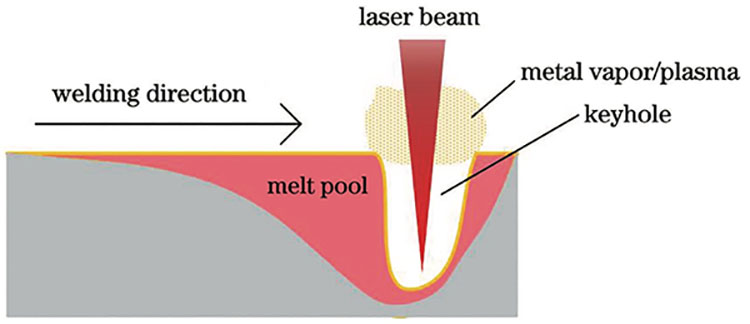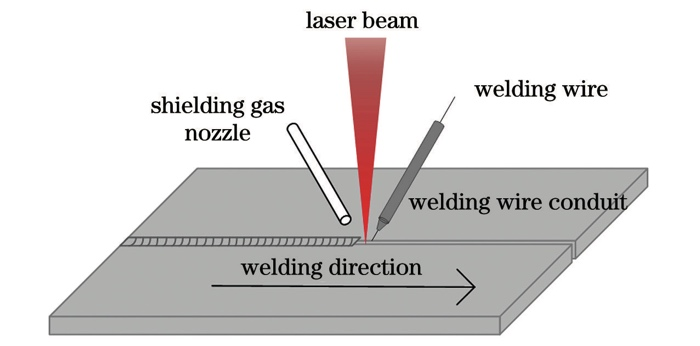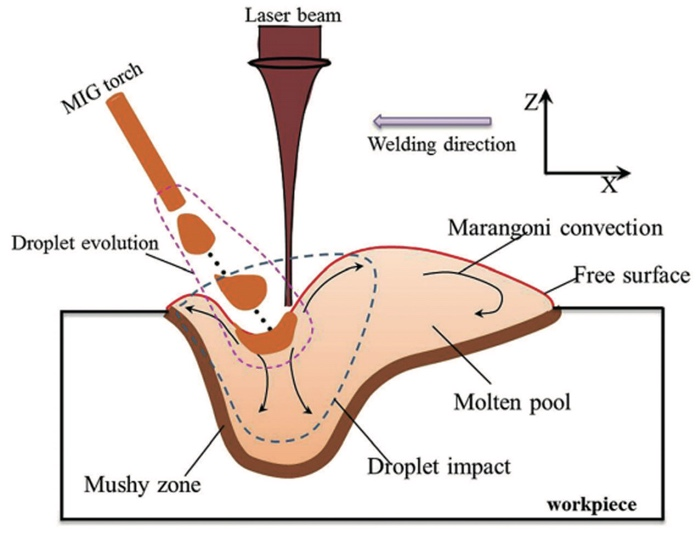Introduction
As the vehicle body is the carrier of other parts of the vehicle, its manufacturing technology directly determines the overall manufacturing quality of the vehicle. Welding is an important production process in the process of automobile body manufacturing. At present, the welding technologies used for automotive body welding mainly include resistance spot welding, MIG welding, MAG welding and laser welding.
Laser welding technology as an advanced optoelectromechanical integration welding technology, compared with the traditional automobile body welding technology, has the advantages of high energy density, fast welding speed, small welding stress and deformation, and good flexibility.
The structure of automobile body is complex, and its components are mainly thin-walled and curved. Automobile body welding is faced with some difficulties, such as changes in body material, different thickness of body parts, diversified welding trajectory and joint forms. In addition, automobile body welding has high requirements on welding quality and welding efficiency.
Based on the appropriate welding process parameters, laser welding can ensure the high fatigue strength and impact toughness of the key components of the car body, so as to ensure the welding quality and service life of the car body. Laser welding technology can adapt to different joint forms, different thicknesses and different material types of auto body parts welding, to meet the flexible needs of auto body manufacturing. Therefore, laser welding technology is an important technical means to achieve high-quality development of the automotive industry.
Laser welding technology of automobile body
Laser deep penetration welding technology of automobile body
The principle of laser deep penetration welding process (Figure 1) is as follows: when the laser power density reaches a certain level, the surface of the material vaporizes, forming a keyhole. When the metal vapor pressure in the hole reaches a dynamic balance with the static pressure and surface tension of the surrounding liquid, the laser can be irradiated to the bottom of the hole through the keyhole, and with the movement of the laser beam, a continuous weld is formed. During the laser deep penetration welding process, there is no need to add auxiliary flux or filler, and the workpiece's own materials can be welded together.
FIG. 1 Schematic diagram of laser deep penetration welding process
The weld obtained by laser deep penetration welding is generally smooth and straight, and the deformation is small, which is conducive to improving the manufacturing accuracy of automobile body. The high tensile strength of the weld ensures the welding quality of the automobile body. The welding speed is fast, which is conducive to improving the welding production efficiency.
In the process of automobile body welding, the use of laser deep penetration welding process can greatly reduce the number of parts, molds and welding tools, thereby reducing the body weight and production costs. However, the laser deep penetration welding process has a poor tolerance for the assembly gap of the welded parts, and the assembly gap needs to be controlled between 0.05 and 2 mm. If the assembly gap is too large, welding defects such as pores will occur.
The current research shows that the weld with good surface forming, less internal defects and excellent mechanical properties can be obtained by optimizing the process parameters of laser deep penetration welding in the welding of the same material of automobile body. The excellent mechanical properties of the weld can meet the needs of the welding components of the automobile body. However, in automobile body welding, the dissimilar metal laser deep penetration welding technology represented by aluminum alloy and steel is not mature. Although welding seams with excellent performance can be obtained by adding transition layers, the influence mechanism of different transition layer materials on IMC layer and their action mechanism on weld microstructure are not clear, and further research is needed.
Automobile body laser wire filling welding process
The principle of the laser filler wire welding process is as follows: a welded joint is formed by pre-filling a specific welding wire in the weld or feeding the welding wire simultaneously during the laser welding process. This is equivalent to inputting approximately homogeneous welding wire material into the weld pool during laser deep penetration welding. The schematic diagram of the laser filler wire welding process is shown in Figure 2.
FIG. 2 Schematic diagram of laser wire filling welding process
Compared with laser deep penetration welding, laser wire filling welding has two advantages in auto body welding: first, it can greatly improve the tolerance of the assembly gap between the auto body parts to be welded, and solve the problem that the laser deep penetration welding requires too much groove clearance; Second, the tissue distribution of the weld area can be improved by using welding wires with different composition contents, and then the weld performance can be regulated.
In the process of automobile body manufacturing, the laser wire filling welding process is mainly used for welding aluminum alloy and steel parts of the body. Especially in the welding process of aluminum alloy parts of automobile body, the surface tension of molten pool is small, which is easy to lead to the collapse of molten pool, and the laser wire filling welding process can better solve the problem of molten pool collapse by melting the welding wire.
Laser brazing technology of automobile body
The principle of laser brazing process is as follows: the laser is used as a heat source, the laser beam is illuminated to the surface of the welding wire after being focused, the welding wire is melted, the melted wire drops and is filled between the parts to be welded, and metallurgical effects such as melting and diffusion occur between the filler metal and the workpiece, so that the workpiece is connected. Unlike the laser wire filling welding process, the laser brazing process only melts the wire and does not melt the workpiece to be welded. Laser brazing has good welding stability, but the tensile strength of the weld is low. FIG. 3 shows the application of laser brazing process in automobile boot lid welding.
FIG. 3 Application of laser brazing in automobile: (a) laser welding of rear hood; (b) Schematic diagram of laser brazing
In the process of automobile body welding, laser brazing process is mainly welding the body parts with low joint strength requirements, such as the welding between the top cover and the side wall of the body, the welding between the upper and lower parts of the trunk cover, etc., Volkswagen, Audi and other high-end models of the top cover are using laser brazing process.
The main defects in laser brazing welding seam of automobile body include edge biting, porosity, weld deformation, etc. The defects can be suppressed obviously by adjusting process parameters and using multi-focus laser brazing process.
Laser arc composite welding technology of automobile body
The principle of laser-arc composite welding process is as follows: using two heat sources of laser and arc to act on the surface of the workpiece to be welded at the same time, the workpiece is melted and solidified to form a weld. Figure 4 shows the schematic diagram of laser-arc composite welding process.
FIG. 4 Schematic diagram of laser-arc composite welding process
Laser-arc composite welding has the advantages of both laser welding and arc welding: first, under the action of double heat sources, the welding speed is improved, the heat input is small, the weld deformation is small, and the characteristics of laser welding are maintained; Second, it has better bridging ability and greater tolerance of assembly gap; Third, the solidification rate of the molten pool is slow, which is conducive to eliminating welding defects such as pores and cracks, and improving the structure and performance of the heat affected zone. Fourth, due to the effect of the arc, it can weld materials with high reflectivity and high thermal conductivity, and the range of application materials is wider.
In the process of automobile body manufacturing, the laser-arc composite welding process is mainly to weld aluminum alloy components of the body and aluminum-steel dissimilar metals, and welding is performed for parts with large assembly gaps, such as the welding of parts of the car door, because the assembly gap is conducive to the play of the performance of laser-arc composite welding. In addition, laser-MIG arc composite welding technology is also applied to the side top beam position of the Audi body.
In the process of automobile body welding, laser-arc composite welding has the advantage of greater gap tolerance than single laser welding, but the relative position of laser and arc, laser welding parameters, arc parameters and other factors should be considered comprehensively. The heat and mass transfer behavior in laser-arc welding is complex, especially the mechanism of energy regulation and IMC thickness and structure regulation in dissimilar material welding is still unclear, and further research is needed.
Other automotive body laser welding processes
Laser deep penetration welding, laser wire filling welding, laser brazing and laser-arc composite welding and other welding processes have been more mature theory and extensive practical applications. With the improvement of the automotive industry's requirements for the efficiency of body welding and the increase of the demand for dissimilar materials welding in lightweight automotive manufacturing, laser spot welding, laser swing welding, multi-laser beam welding and laser flight welding have been paid attention to.
Laser spot welding process
Laser spot welding is an advanced laser welding technology, which has the advantages of fast welding speed and high welding precision. The basic principle of laser spot welding is to focus the laser beam to a certain point on the part to be welded, so that the metal at the point is instantly melted, by adjusting the laser density to achieve thermal conduction welding or deep fusion welding effect, when the laser beam stops acting, the liquid metal reflow, solidified to form a joint.
There are two main forms of laser spot welding: pulsed laser spot welding and continuous laser spot welding. Pulsed laser spot welding laser beam peak energy is high, but the action time is short, generally used for magnesium alloy, aluminum alloy and other light metals welding. The average power of laser beam in continuous laser spot welding is high, the laser action time is long, and it is widely used in steel welding.
In terms of automobile body welding, compared with resistance spot welding, laser spot welding has the advantages of non-contact, spot welding trajectory can be designed independently, etc., which can meet the requirements of high-quality welding under different lap gaps of automobile body materials.
Laser swing welding process
Laser swing welding is a new laser welding technology proposed in recent years, which has been widely concerned. The principle of this technology is: by integrating a galvanometer group on the laser welding head, the laser beam is quickly, orderly and in a small range, so as to achieve the effect of the laser beam moving forward while stirring.
The main swing trajectories in the laser swing welding process include transverse swing, longitudinal swing, circular swing and infinite swing. The laser swing welding process has significant advantages in the welding of automobile body. Under the action of the laser beam swing, the flow state of the molten pool is significantly changed. Therefore, the process can not only eliminate the unfused defect, achieve grain refinement and suppress the porosity in the welding of the same automobile body material. In addition, it can also improve the problems such as insufficient mixing of different materials and poor mechanical properties of welds in the welding of heterogeneous materials of automobile body.
Multi-laser beam welding process
At present, the optical fiber laser can be divided into multiple laser beams by a splitter module installed in the welding head. Multi-laser beam welding is equivalent to applying multiple heat sources in the welding process, by adjusting the energy distribution of the beam, different beams can achieve different functions, such as: the beam with higher energy density is the main beam, responsible for deep penetration welding; The lower energy density of the beam can clean and preheat the surface of the material, and increase the absorption of laser beam energy by the material.
Galvanized high-strength steel material is widely used in automobile body. Multi-laser beam welding technology can improve the evaporation behavior of zinc vapor and the dynamic behavior of molten pool in the welding process of galvanized steel plate, improve the sputtering problem, and enhance the tensile strength of weld.
Laser flight welding process
The laser flight welding technology is a new laser welding technology, which has high welding efficiency and can be designed independently. The basic principle of laser flight welding is that when the laser beam is incident on the X and Y mirrors of the scanning mirror, the Angle of the mirror is controlled by independent programming to achieve the deflection of the laser beam at any Angle.
The traditional laser welding of automobile body mainly relies on the synchronous movement of laser welding head driven by welding robot to achieve welding effect. However, the welding efficiency of automobile body is severely limited by the repetitive reciprocating motion of welding robot due to the large number of welds and long length of welds. In contrast, laser flight welding only needs to adjust the Angle of the mirror to achieve welding within a certain range. Therefore, laser flight welding technology can significantly improve the welding efficiency and has broad application prospects.
Summary and prospect
With the development of the automobile industry, the future body welding technology will continue to develop in two aspects: welding process and intelligent technology.
Automobile body, especially new energy vehicle body, is developing in the direction of lightweight. Lightweight alloys, composite materials and dissimilar materials will be more widely used in automobile body, conventional laser welding process is difficult to meet its welding requirements, so high-quality and efficient welding process will become the future development trend.
In recent years, emerging laser welding processes, such as laser swing welding, multi-laser beam welding, laser flight welding, etc., have been preliminary theoretical research and process exploration in terms of welding quality and welding efficiency. In the future, it is necessary to closely combine the emerging laser welding process with lightweight materials and dissimilar materials welding scenes of automobile body, conduct in-depth research on the design of laser beam swing trajectory, the action mechanism of multi-laser beam energy and the improvement of flight welding efficiency, and explore a mature lightweight automobile body welding process.
The laser welding technology of automobile body is deeply integrated with intelligent technology. The real-time perception of laser welding state of automobile body and the feedback control of process parameters play a decisive role in welding quality. The current intelligent laser welding technology is mostly used for pre-welding trajectory planning and tracking and post-welding quality inspection. At home and abroad, the research on welding defect detection and parameter adaptive control is still in the initial stage, and the laser welding process parameter adaptive control technology has not been applied in the automobile body manufacturing.
Therefore, in view of the application characteristics of laser welding technology in the process of automobile body welding, an intelligent sensing system for laser welding with advanced multi-sensors as the core and a high-speed and high-precision welding robot control system should be developed in the future to ensure the real-time and accuracy of all aspects of intelligent laser welding technology. Open the link of "pre-welding trajectory planning - parameter adaptive control of welding quality online detection after welding" to ensure high-quality and efficient processing.
Post time: Oct-16-2023




